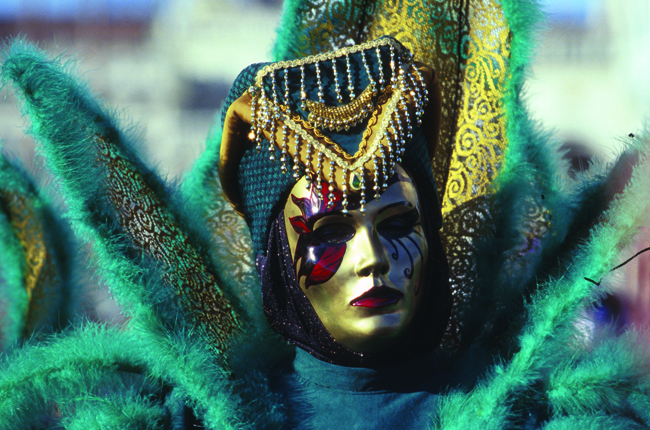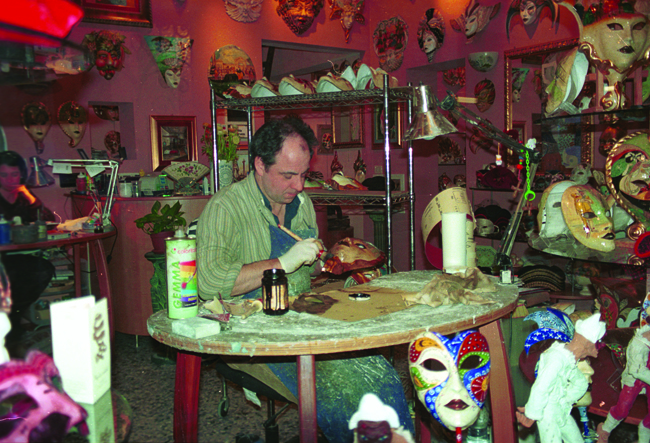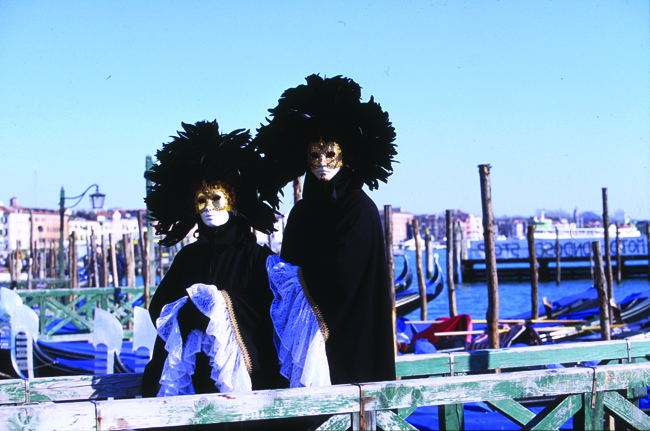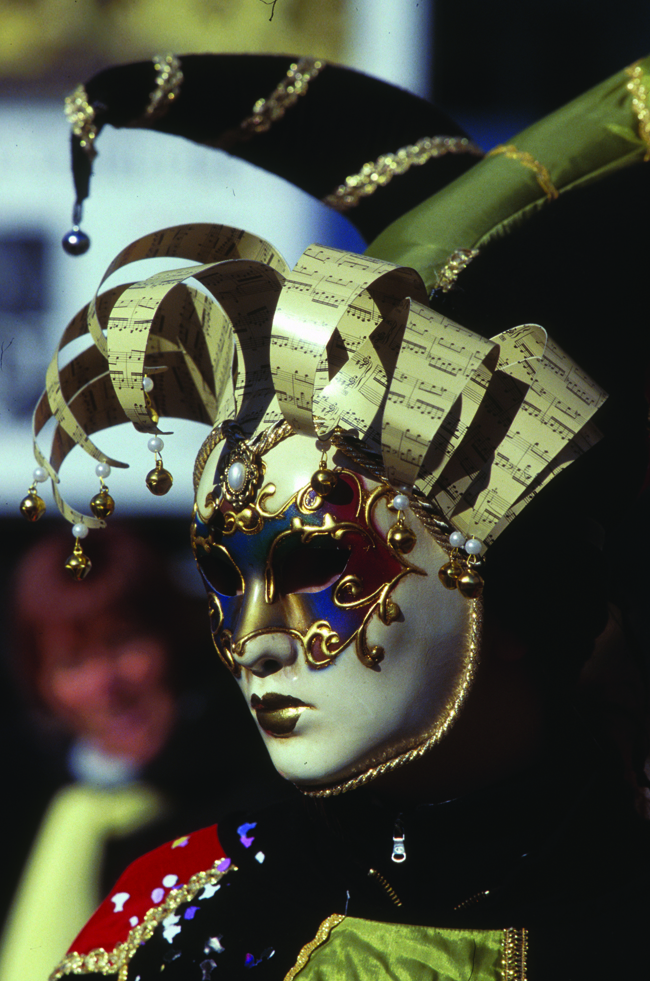Since the height of its 17th-century splendour, this seductively sensuous Carnevale has lured visitors from afar. Sadie Briggs visits Venice in search of the magic behind the masks.

Being swept along tall, narrow streets in an anonymous crowd of beautifully opulent revellers with music, shouting and whoops of excitement coming from every direction, can be terrifying for some – but wild fun for others. Welcome to the most theatrical outdoor madness of the year: Il Carnevale di Venezia. The streets of Venice, bursting with Venetians and visitors from all over Italy as well as the world, get pushed well beyond their normal capacity for over-crowding during Carnevale. Glamorously settecento costumes and masks of every kind amaze and astonish with their elaborate decadence, whisking you back to more elegant times; although they are often outnumbered by gawping, camera-happy tourists. This year, my Venetian friend Lucia kindly lent me her costume (she had a new one), so complete with corset, gloves and ostrich-feathered mask, we flung ourselves into the fray in true Venetian style.
There really is nothing like it anywhere else, but it is not for the faint-hearted or those prone to bouts of crowd rage – and Sunday is to be avoided as it is impossible to move at all. Every day, public shows are organised in the squares and evenings end in private parties in maschera.
Venice Carnival can rightly boast to being the most famous in the world. Not many people know that the word ‘carnival’ comes from the Latin phrase, ‘Farewell, meat’.
Originally, Carnival lasted from 26 December to Ash Wednesday, when Lent obliged people to fast. So, during the festivities, all meat, butter and eggs (plus any other sins, it seems) had to be used up, and human nature being what it is, this religious formality became the excellent excuse for licentious partying. Despite efforts by various Popes to return Carnevale to within its proper religious limits, Venice determinedly continued to party.

Carnevale began after 1162; a document from 1268 first mentioning the use of masks. Its glory days were, however, in the 17th century, when Venice’s decline in political power seemed to be compensated for by a rise in the arts and a consumption of pleasure so conspicuous it drew in rich young nobles doing the European
‘Grand Tour’. Costume temporarily liberated Venetians, under the watchful eye of the Doge’s government. If you cannot identify the mask wearer, his social status is hidden and thus social order becomes temporarily overturned. However, the controlling Doges were a little nervous regarding this ‘danger’, strictly limiting the use of
masks to the carnival period. Carnevale subsequently ceased, was revived after centuries in 1979, and now takes place annually for the ten days preceding Ash Wednesday (Mardi Gras). Carnival 2005 ended on Tuesday 8 February.
If you’re lacking a mask, there are plenty of street artists waiting at every corner who will gladly transform your face into unrecognisable strangeness (often smudged into an unrecognisable mess by the evening). Friends who do this tell me they work non-stop and make a fortune, as well as meeting all types of people and having great fun.
BEHIND THE MASK

In the city of disguise, however, nothing is more intriguing and dangerously attractive as a real Venetian mask. Masks change you. Even today they give the opportunity
to momentarily flee what you know and indulge in a fantasy world which is anything but childish. This is the sensual world of Eyes Wide Shut, where, hidden behind your mask, you also imagine who is hidden behind those who surround you. It’s a gamble: beauty can become ugly, youth can become haggard, women can become men. Do you want to know what lies behind the mask? Nothing adds to this slightly uneasy, storybook feeling of Venice, than the dark, theatrical mask shops, with their low beams and small doorways. Trying a mask is an initiation ceremony, an entry into Venice as it was and still is.
The maschereri were founded to meet the growing need for masks. Bauta was the most fashionable: a unisex costume of black tricorn hat, white papier-mâché mask and black cloak. The sinister white-beaked mask represents the Plague Doctor, who would wear a similar costume when visiting patients afflicted with the plague. The long beak represents the perfume-filled breathing apparatus the Plague Doctor used to prevent himself from being infected. Gianfranco Lojacono, born in Venice in 1967, worked with the old maschereri of the city, before founding La Venexiana in 1991, along with three others.

They continue to make masks in the old way, first forming the mould using a volunteer, whose face is covered in Vaseline then spread with quick-drying plaster. This is used to produce the clay mould over which the papier-mâché mask is shaped and strengthened with vinyl glue before being sandpapered smooth. The eyes, nose and mouth are shaped with scissors, then three coats of watery plaster and glue perfect the surface. Oil colours bring the fantasy character tolife, finished with an aged-glaze
to become another authentic face from Venice’s glory days.
DOING IT YOURSELF
Carnival costumes should in theory be sensual, sophisticated and clearly of an epoch, but it does not always work out that way. Venice too suffers from DIY efforts thrown together from bedsheets and a tiara – or worse – and there are distinct styles of reveller on the streets. The smallest and cutest ones are not very old, are very loud and very well-dressed as princesses, Barbies, cowboys, Zoros and Spidermen. The next age range tends to be masked teenagers in black capes, disguised so as not to be recognised by parents while dodging tourists, cigarettes and bottles ofwine in hand.
 The middle-aged American tourist stands out a mile, wearing the most elaborate mask they dare, complete with jeans and T-shirt. British and German tourists get noticed by turning up in the most inappropriate Halloween/stag-night costumes, while the business set roll out from luxury hotels to swish dinner parties and balls in hired costumes. Yet the last, most wonderful set – perhaps also the maddest – are those in total command of Carnevale. Swathed in elaborate, authentic costumes of an epoch never forgotten here, they rise out of the folly on every step and platform they can find, especially on the balustrade of the Campanile, their weird poses attracting 24-hour attention.
The middle-aged American tourist stands out a mile, wearing the most elaborate mask they dare, complete with jeans and T-shirt. British and German tourists get noticed by turning up in the most inappropriate Halloween/stag-night costumes, while the business set roll out from luxury hotels to swish dinner parties and balls in hired costumes. Yet the last, most wonderful set – perhaps also the maddest – are those in total command of Carnevale. Swathed in elaborate, authentic costumes of an epoch never forgotten here, they rise out of the folly on every step and platform they can find, especially on the balustrade of the Campanile, their weird poses attracting 24-hour attention.
Everyone with Carnevale spirit dreams of losing themselves in the magical and unforgettable atmosphere, reliving the age-old game of passion and seduction. The Ballo dei Sospiri on Friday 4 February, promised just that. Its theme of Virgins and Vampires brings out the truly erotic and wickedly risque nature of the masquerade. Guests dressed in period costume arrive by gondola at the Ca’ Zenobio palace at 8.30pm for a welcoming aperitif, before being shown to the ‘noble floor’ sit-down dinner, with candle-lit tables elaborately set according to Venetian tradition.
